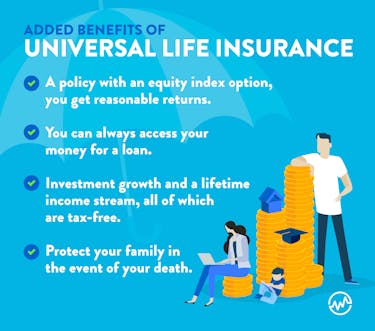

Get Access to 250+ Online Classes
Learn directly from the world’s top investors & entrepreneurs.
Get Started NowIn This Article
Let’s be honest: we don’t enjoy pondering our own mortality. That’s why many of us don’t even want to think about life insurance. Yes, you probably know that life insurance is an important tool both for estate planning and protecting your loved ones in the event of your death. But did you know it can actually help you build your wealth in the meantime?
In The Hidden Power of Life Insurance, Stuart Arakelian explains how life insurance works, why it pays to have life insurance for your family, and how you can use it to build your own wealth over time.
How Does Life Insurance Work?
When you pass away, you want to ensure sure your children’s school or university tuition can be paid so they aren’t buried by loans. You also want to ensure the mortgage is taken care of so your spouse doesn’t have to move the family. Plus, you want your family to not have to stress over the cost of a funeral. Life insurance can cover these costs.
Simply put, life insurance gives your survivors money to take care of necessary expenses.
Estate taxes are a big expense confronting the heirs of high net worth individuals. In addition to minimizing estate taxes through careful estate planning, having life insurance to cover remaining taxes can help your family.
Non-family members can also use life insurance to protect themselves. For example, a business owner could purchase a life insurance policy covering his partner.
If the partner dies, the business owner will have a lump sum of cash available to buy out the partner’s surviving spouse or other heirs.
Types of Life Insurance

In the course, Arakelian emphasizes that all consumers should look carefully at all three types of life insurance to determine which one, or which combination, best fits their needs.
Some insurance agents will try to steer you aggressively to one type — be wary of this and do your own research.
The difference between the three types is primarily in the investments that determine the cash value of the insurance policy.
How does life insurance work in terms of cash value?
Term life insurance is the least expensive, but it covers you only for a set “term” of time and the policy has no cash value. The only payout comes if your death occurs during the term.
Whole life insurance covers you for your whole life, and builds up significant cash value. The downside is it’s a lot more expensive than term life insurance.
Universal life insurance is a hybrid of the two. It covers you until your death and builds up cash value like whole life insurance. But it’s less expensive, albeit not quite as cheap as term life insurance.
Everyone has different needs. It pays to figure out which type of insurance best suits yours. Let’s look at each one more in-depth.
Term Life Insurance
Term life insurance is a good solution for younger consumers who have a limited budget or only need coverage for a short “term” of time. It tends to be cheap for younger adults ages 25-50.
How does life insurance work when it comes to pricing? Term life insurance gets more expensive as you get older. Buying a policy under age 30 is cheaper than buying one before you hit 40.
As the likelihood of your death increases, term life insurance becomes more expensive. Its main benefits are for short-term needs and younger people.
Let’s say you’re a young entrepreneur. You start a new venture with a partnership agreement that will last for 5 years. A 5-year term life insurance policy will cover you in the unlikely event your death happens before the agreement terminates.
Similarly, a term life insurance policy can protect your family if you take out a short-term loan to fund a startup. If you die, the insurance will pay back the loan, and your family won’t be on the hook.
Another benefit to term life insurance is the option to convert your term policy to a whole life policy in the future, at the same rate as your original policy.
This pays off hugely if you have a health event a few years after purchasing a term life insurance policy that makes you ineligible for a term policy. The rate you pay when converting will be the rate you would have paid while still healthy as a horse.
However, once the term runs out, this low-cost, short-term insurance doesn’t leave you with any return on your investment.
There is no cash value.
If you want to continue maintaining life insurance coverage, and you only had a term life policy, you’ll need to purchase a new policy. This policy will cost a lot more now that you’re older.
Given increasing life expectancies, less than 1% of term life insurance policies actually end up paying a claim. Insurance companies know this — it’s why they’re cheap.
As an aside, there are very specific life events that may make term life insurance well suited to your needs.
If you divorce or separate from your partner and you share minor children, you will have a child support obligation that lasts until your youngest child is 18, 21, or even 23 years of age.
You may also be responsible for higher education costs over the age at which child support terminates.
For this very specific need, covering a short period of time, having a term life insurance policy will guarantee your financial obligations are met.
Once your children are grown, you won’t need the policy anymore, and lack of cash value won’t matter.
Whole Life Insurance
Whole life insurance has significant benefits. The premium payment is set for life, so what you pay at age 25 per month is the same as what you’ll pay at age 75.
Because whole life insurance policies have an actual cash value, you may receive dividends if the money in your policy is invested in funds that pay dividends.
Tax benefits to whole life insurance include
- tax-deferred returns on your investments
- tax-free withdrawals
- tax-free death benefits
The death benefits are more extensive.
The growth in the cash value of your policy and dividends paid are likely to increase enough over time to be able to cover the monthly premium payment.
In other words, you’ll get to a point where the policy pays for itself.
The downside to whole life insurance is the high cost of premium payments in the early years, and the requirement that premiums be paid in full in the first 5-7 years (when the cost is very high compared to term life insurance).
Universal Life Insurance
Universal life insurance includes the whole-life coverage, and tax-deferred cash value accumulation and tax-free death benefits of whole life insurance.
However, instead of the fixed high premiums of whole life insurance, universal life insurance allows you to float the size of your premium payment over time, paying more per month when you can afford to do so.
Whole life insurance companies charge a higher fee in exchange for greater investment security, reflected in your premium payments.
If the investments do well, you’re paid dividends.
How does life insurance work if you choose a universal policy? Universal life insurance companies charge a lower premium, and how you invest your money will impact your risk and reward.
If you prefer to take more risk in order to obtain potentially higher cash value at the end of the day, universal life insurance is better for you than whole life insurance.
Under the umbrella of universal life insurance, you can invest your policy in one of the following three product categories: fixed-rate, index equity, or variable subaccount.
Fixed-rate Option
This is invested in short-term bonds for consistently reliable performance, resulting in an average 4% return.
Variable Subaccount Option
Here, you build your own investment allocation among 60-100 different options, which will likely out-perform short term investments. This option comes with similar risks to investing in the stock market.
Index Equity Option
This provides upside potential without the downside risk of variable insurance. The S&P 500 index pegs the cash value of index equity universal life insurance, so you don’t have the widest array of options available.
Since the cash value of universal life insurance is tax-free, you can use it to finance your children’s education or invest in your business, allowing you to build wealth over time.
Index Universal Life Insurance
You can actually build wealth by using your life insurance policy. So how does life insurance work in order to give you these benefits?
If you choose a universal life insurance policy and the equity index option, you will generally receive the majority of the performance of the S&P 500 index each year minus dividends paid by the funds in a positive-performing year.
There will also be a market cap where the insurance company keeps any returns over a certain amount, such as 10% annually.
If the stock market goes down and there is a negative-earning year, the policyholder doesn’t lose anything, but you won’t earn anything either.
The dividends the life insurance company withholds in a good year will be used to pay itself back in a bad year, since the company is guaranteeing that policyholders won’t lose anything.
Arakelian explains the theory behind this idea: if a policyholder has the chance to earn more than the average 4% return offered by whole life insurance policies and other kinds of universal life policies, with no risk of losing their initial investment, holding back the dividends and returns in excess of the market cap will be competitive versus a fixed rate product such as a whole life or regular universal life.
You could just invest in a brokerage account if you’re comfortable with higher risk, but you can’t receive free death benefits, tax-deferred growth, and tax-free withdrawals without life insurance.
In addition, whole or universal life insurance policies have a significant benefit compared to retirement plans.
You can take a tax-free loan with a competitive interest rate from a life insurance policy at any age.
If you take a loan from a Roth or regular IRA or 401K prior to age 59 ½ you will incur a 10% penalty, plus full taxes.
That’s why life insurance is a good way to build your wealth.
It allows the following:
- maximizes tax strategy while allowing for decent returns on investment
- allows for tax-free loans
Of course, you can take advantage of all tax-deferred retirement account options and insurance at the same time.
How does life insurance work? It works as part of an overall plan to build your wealth by maximizing all possible avenues depending on your current and potential future income and tax brackets.
The $1,000/Month Example
Let’s look at what happens if a 35-year-old male purchases a $1,000,000 life insurance policy and pays $1,000 per month in premiums. Assume a return on investment of 5.3%.
At age 55, the policyholder has paid $240,000 into the policy. At 5.3% returns, it’s grown to $325,000.
All $85,000 in gain is tax-free forever if structured properly.
The death benefit of the policy is now $1,325,000, and it’s also tax-free.
At age 60, the policyholder has paid $300,000 into the policy. The cash value is now $480,000.
The $180,000 in gains are tax-free, and the death benefit is now $1,480,000.
Even with a very conservative investment return assumption, you still get the tax-free gains, however small; a tax-free death benefit; and the ability to withdraw cash for education or investment and simultaneously protect your family with the death benefit
If investment returns are low, then other investments like retirement and regular brokerage accounts would also have had low returns over this period of time, but you wouldn’t get the death benefit for your family that you do with universal life insurance.
Plus, at age 65, the policyholder realizes the growth of $675,000 on their policy.
This translates to a tax-free $45,000 annual income for the rest of your life.
You could have more growth and more income from a retirement account, but it’s fully taxable. The net amount would be less than what you get from universal life insurance.
Hidden Power of Life Insurance

How does life insurance work? If you choose correctly, it works by providing competitive returns that may not match what you get with other investments, making up for it with a slew of unmatched benefits.
With a universal life insurance policy with an equity index option, you get reasonable returns.
You can always access your money for a loan.
And you get investment growth, death benefits, and a lifetime income stream, all of which are tax-free.
Most importantly, you’re getting all these benefits while protecting your family in the event of your death.






